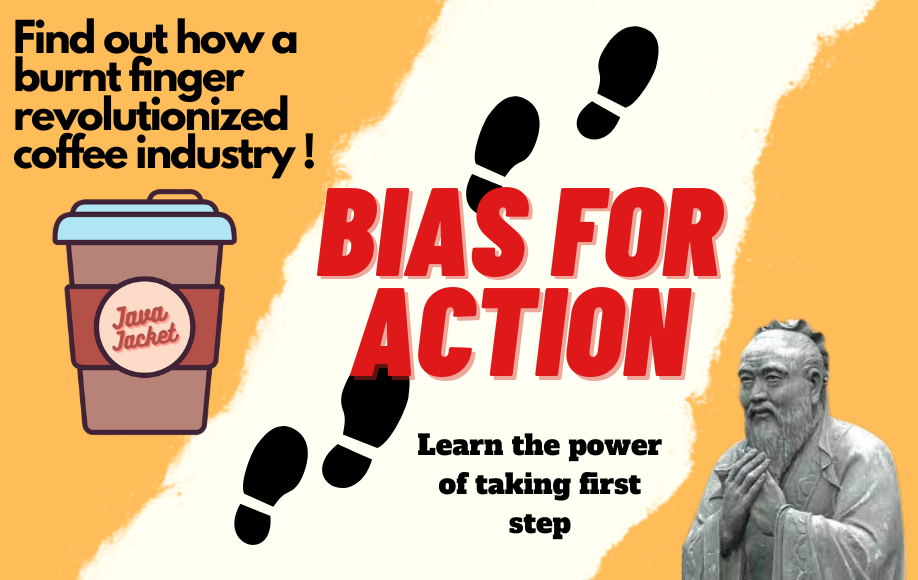Some lessons have to be experienced before they can be understood
Michael Batnick (Investor)
Story of Java Jacket
Back in 1989 Jay Sorensen a struggling realtor, pulled into a coffee shop drivethrough to get his morning cup of coffee. While on the way out of the drive through coffee spill burned his fingers, forcing him to release a blistering hot cup of coffee onto his lap. While this incident may not have been good for Jay’s lap, it was however phenomenal for his career as he chanced upon an innovative idea which went on to make the life better for millions of routine coffee drinkers.
The incident made Sorensen realise that there had to be a better way to drink coffee on the go. He quickly converted that idea into action and a 2 year period of trial and error finally yeilded what he called Java Jacket a coffee sleeve.

Today, approximately 1 billion Java Jackets are sold each year to more than 1,500 clients. You can find that Coffee Sleeve sitting alongside renowned works of arts done by the likes of Vincent Van Gough & Andy Warhol, in New York’s Museum of Modern Art (MoMA).
Just like Jay, we come across many problems or ideas in our day to day life but we choose to simply ignore them or we park those ideas for later when we are willing to take action. But that time seldom comes and we again engage in the cycle of bookmarking new ideas. That’s what differentiates people like Jay Sorenson, who instead of choosing to move on with his life, had a Bias For Action which made him start working to develop a solution for the problem he faced. In the following passages we would learn What is Bias For Action ? and why developing it is necessary in today’s age and society.
What is Bias for Action ?
Bias for Action is an approach to favor action over inaction. Its inclination to respond with action even without a solid rationale to support it. Impulse to act is hardwired in our DNA as a means of survival. When danger arose, our ancestors acted either by running away or fighting. They knew inaction would lead to loss of their life.
Similarly, In life we come across many problems where our pace of decision making determines whether or not we would succeed. The reason we are unable to take the first step is because we feel hesitant. Fear of failure overpowers our desire to succeed and cripples our ability to move forward.
Many people think they lack motivation but what they actually lack is clarity.
James Clear (Author of Atomic Habits)

Why should one have Bias For Action ?
What if, instead of solving the problem of holding hot styrofoam cup, Jay Sorenson simply cursed his luck and carried on with his life. This story of “from rags to riches”, from struggling realtor to a millionaire, could only be possible because Jay decided to take action to solve a problem which might seem pretty ordinary was infact experienced by hundreds and thousands of people.

It’s the 2 year period of persistant trial and error that yielded the first Coffee Sleev. Persistence drives continous learning and charts a path to perfection. However, persistance can only be possible if efforts are put in the right direction. Efforts are thus the foundation of persistance, it’s the efforts that are done over time helps to build a bias for action which further produces successful results. Bias for Action plays crucial role in many walks of life such as:
- Diagnoses : If a patient presents unusual symptoms that are difficult to diagnose, but don’t seem to be posing immediate threat to patient’s well-being. In such cases doctors prefer to engage in action by choosing a full body checkup instead of scheduling a follow-up appointment.
- Business: In a tech driven world companies are fighting to outpace each other in terms of advancements. It’s important to move fast than to be 100% sure about every little detail.
- Education: People hold on to their ambitions of switching a career because it requires them to complete a 4 year course. They forget that regardless of whether they choose to take that course or not they would still be 4 years older.
How to develop the Bias for Action?
After conducting series of experiments and not getting desied result in each one of them, when Thomas Edison was asked about his experience he said I haven’t failed, I’ve just found 10,000 ways that won’t work.”
Take that First Step
Fear of failure did not bother Edison, his willingness to take action, is what kept him going and that is where the heart of Bias for Action lies. It is willingness to take that first step. An objective or macro result which often looks hard to achieve, is nothing but a culmination of micro actions which often are easy to take and it’s just a matter of taking that first step. That’s what separates Doers from Dreamers.
It does not matter how slowly you go as long as you do not stop
Confucius

Learn While you Earn
Age old notion of first learn then earn has been flipped today, as now people prefer to learn while they earn. One learns a lot more by doing then simply sitting and pondering over the problem. Performing action is actually the quickest way of learning. Mistakes that you make during the process prove to be a better teacher than textbooks.
Employ heuristic technique, which is a problem-solving approach that utilises uses a practical method in order to produce solutions. Desire to learn should be fulfilled by learning and not by stacking ideas. Time to stop the game of bookmarking and start reading those articles/posts.
Skin in the Game
Just like our ancestors who feared inaction would lead to loss of their life, unless we have something to loose we are not bothered about the consequences. We don’t take any action unless we have something on the line. This phenomenon is referred to as having skin in the game, unless you face the fear of loosing the game or reputation you won’t be committed to take an action.
Employees should have some stake in the business in order for them to get up and start taking necessary actions to keep it afloat. Commitment is driven by having skin in the game which further propelles us to take an action to avoid consequences . it’s difficult to bother about a problem. . We need to commit to take action. Implementation Intention
Calculated Risk Taking
Tech Giant Amazon, lists Bias for Action as one of its 14 leadership principles. Their mantra is to put words into action as quick as possible while taking calculated risks. The way Amazon describes it as follows “Speed matters in business. Many decisions and actions are reversible and do not need extensive study. We value calculated risk taking.”
The key here is to understand upfront if your decision two way door decision i.e is changeable and reversible without a lot of damage. If yes then you shouldn’t waste much time in discussions but rather work on implementing that decision. The learning obtained after implementation can then be used improve the next iteration. The continous feedback of test-learn-implement, is what makes a product ready for deployment. Amazon calls this process an “Organizational Yes”.


